Home
/
Articles
/
Tatyana Turaeva "Bikram Yoga – take care of your heart!"
Tatyana Turaeva "Bikram Yoga – take care of your heart!"
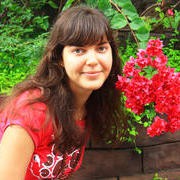
Tayana Turaeva is a certified instructor, she teaches yoga since 2008. To further deepen her knowledge she took a course of lectures “Anatomy and physiology”. She has an experience of teaching in groups and individual programs, including for those who have problems with the spine. In her yoga practice she includes elements of qigong and meditation.
Her personal interest is studying positive influence of yoga practice on health and possibility to help in various diseases by its physical means (asanas, pranayamas) and psychophysical means (correct understanding of various situations, positive thinking).
In this article she describes her visit to one Bikram Yoga studio in Moscow. The aim of the visit was to personally experience this methodology and make comments on the effectiveness of this type of practice.
Editorial notes: Bikram Choudhury was born in Kolkata, India, in 1970s he came to the USA and founded a net of yoga studios, then he patented his method that includes a sequence of 26 asanas fulfilled in conditions of high humidity and temperature. This method is taught within Bikram Instructor courses (it costs 5000USD) and is spread like a franchise (studios of Bikram Yoga all over the world pay a certain percentage to the author). He was also trying to patent asanas themselves but got refusal from United States Copyright Office (USCO) as asanas are considered to be a world’s heritage. Bikram Choudhury is one of the richest yoga instructors in the world. In the USA he is also famous for a series of loud court cases with his former students, who tried to copy his method, as well as for accusations of sexual harassment and rough, offensive phrases in interviews to the media.
Medical aspects of a doubtful trendy practice
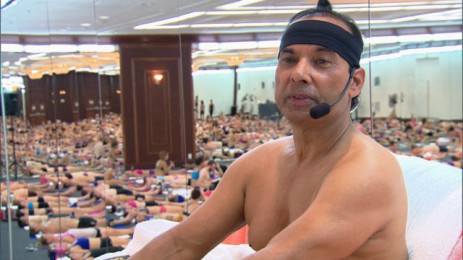
The first Bikram Yoga studio is open in Moscow… Being aware that this kind of hatha yoga is popular in America and Europe, I decided to get my own experience. Another purpose of the visit was to make an adequate (though not without a subjective tone) evaluation of the practice for those who is looking for a practice that suits them best and is looking for their self in a practice. Correspondingly, going for a class, I was keeping these moments in my mind. I was not looking there for any internal or spiritual practice (thankfully in my case this work is carried out under a competent supervision), I wanted to see how the conditions created in a classroom (temperature +35-40 C and high humidity) allow improving body’s flexibility. So, I turned my mind into an analytical and logical mode, in order to express not just my personal impressions but mainly the facts from the point of view of anatomy, physiology and a reasonable mind. Due to that I present the information in four parts:
- about the method itself (pros and cons, complaints);
- about the concrete studio;
- about one concrete class and instructor;
- a list of contraindications (as I did not find any neither in a studio no on their website).
I should mention right away that before going for a class I’ve studied carefully the website hoping to see the exact information about the temperature and the humidity in a classroom, and contraindications (I will list them in a separate part of the article). To my regret I did not find this information on the website. It is a pity because conditions of a practice are untypical. Many people during ordinary yoga classes often complain about heat and lack of air, and here this is a key condition of the practice. Habitants of the middle part of Russia do not normally spend every day in conditions of +40 C and humidity of 90%. Similar conditions are typical to weather in Turkey in August… At the same time on the website I found the information about asanas which I was supposed to fulfill. Personally, I’ve assessed the level as very easy. But it is “personally”.
About the method itself
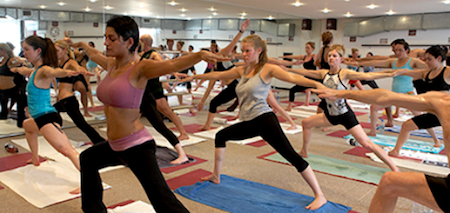
The temperature conditions are +35-40 degrees centigrade (I do not know exactly: there is no information on the website and there is no thermometer in a classroom. This secret should have been hidden somewhere in a franchise contract). There are 26 asanas. Mainly they work through the main moving directions of the spine and joints of the legs. Work with shoulders is rather poor. The method does not suggest any development or improvement. Generally speaking, after the lectures on Yoga Anatomy and Physiology, after practicing yoga, for example with Anatoly Zenchenko (Ishvara Yoga), Inna lee (Kali Ray`s Tri Yoga) or Andrey Lappa (Universal Yoga), this method seems to be very simplified.
My analytical mind was disturbing me since the first seconds in a classroom. When I’ve entered the room besides the temperature and humidity I felt a smell of “heated mats”. When I sat down on a mat (I took one in the studio) and covered it with a towel, I thought “What does the rubber extract when heated?”, “What about the laminated plactic?”, “Plastic windows?”, “The ceiling and plasterboard?”
As I am not a big specialist in this area I would not mention here frightening and complex names of all these substances. I did not search the internet very precisely. I can say one thing – it is not recommended to keep acrylic resin (normally laminated plastic is covered with it) in temperatures higher that 20C. Logically we assume that it concerns laminated plastic itself as well. I do not know what does acryl extract when heated but according to storage requirements it definitely extracts something. Similar situation is with plastic windows and other elements interior decoration. Ideally the place should be decorated inside by wood of high quality or stone. But it is cost consuming, that is why here everything is simple…
One and a half hours before the class I drank 0.6 liters of water. Correspondingly, I was not sweating very much. Generally this place looks like a club for those who is not satisfied with their appearance and are eager to lose their weight. Most of the women were of thick constitution (I’m not against it, it’s just a fact). I did not have a goal to lose any weight; I’m fine with mine – 63 kilos and the height is 182 centimeters. So I was looking a bit weird among those willing to become thin. Talks were relating to the topic: “Oh, you’ve lost your weight, how did you do it?” “I almost do not eat anything.”
I can say that one of my friends, a fitness instructor, and a very competent person in questions of losing weight, was doubtful about the effects of this method. The organism is just put into the conditions where it is forced to actively extract water through the skin – it is a mechanism of coping with the heat, an attempt to chill out. Besides, before the class a lot of water was consumed. Organism is losing water but it does not mean that it is a result of fat breakdown in a mitochondrion of a cell. To make this happen you need to break up fat layer first. Usually it is done through dynamic powerful exercises which are more intensive than this practice. It looks like an advertisement “fitness class + sauna afterwards = 5 kilograms less.” It is not true. Every fitness instructor or a person with medical background can explain you that. You just lose liquid, the body is dehydrated. When you drink water again, the weight returns. This method of weight loss was tested in one TV program “Moscow. User instruction” on TNT channel. The weight comes back after the water is consumed again. Thus a slogan like “Want to lose your weight – go to Bikram Yoga” can only motivate those who are not familiar with constitution and functioning of a human body.
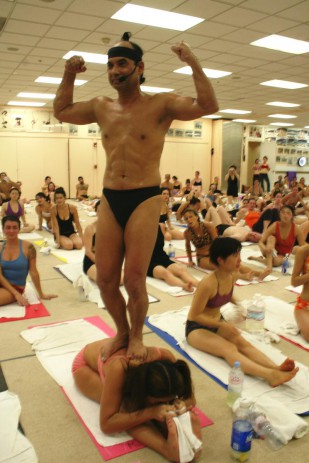
I can explain the fact of weight loss by the fact that after the class you do not want to eat, as actually happens in a hot weather.
The second, I was interested in improved flexibility that happens in such conditions. The class did not improve my flexibility; I can fulfill all the asanas of the complex without warming up. The other case is that improved flexibility in conditions of high temperature and humidity does not guarantee that the result will remain in normal conditions. Many of the yogis I know told me that in the south the body becomes flexible like plasticine. But in Moscow reality, especially in winter, the body looses the gained flexibility. Thus, flexibility would improve, but only in the class, only in such conditions. It would probably improve globally, but not much.
Generally, I got used to a correct practice with proper alignment of body positions, and for me it was difficult to work in a class. I could argue the alignment of almost every asana.
The first, shoulders were raised up practically in all the poses. For many years I was taught that it should be vice versa, but here…! Raised up shoulders provoke tension of trapezius and scalene muscles, suppress the carotid artery and may cause difficulties in blood outflow from the brain!
In backward bends and preliminary pranayama the head is tilted back on purpose (!), with a hindhead moving towards shoulder blades. This position is traumatic for the neck and also hampers the blood outflow from the brain. Forward bends start from the neck bending: the chin is lowered to the chest in order to influence thyroid, which is unacceptable in cases of hyper function of the gland.
In bends and twists they use the work of the hands. It means that we are pulling ourselves into these positions. Among those with problems in the spine it can cause discs’ displacement in lumbar part of the spine, besides it is also contraindicated in cases of hernia. The adequateness (its lack) of the practice surprised me badly. In this method there is no understanding what functions how. Or there is an understanding but it’s purely Indian - to accept everything by trust, that’s what Bikram gives to his students. “Our teacher looks good because he practices like this, and you should do the same.” It is disputable, especially for a modern westerner who tends to analyze and to test everything. The popularity of this kind of sport looks very strange for me. This practice can be popular among the people with a low level of knowledge. How is it possible to suggest students to fulfill a half-lotus pose without any preliminary preparation? If there are problems with the knees (this practice is positioned as the one that helps people with knee problems) it is better not to do it until you work through your hip joints! There are forward bends in a practice and for flexible students it is recommended to transfer the weight of the body towards the heels and straighten the knees, to unbend them too much. It is harmful for the joints.
I did not like the variant of Utkatasana either when we were squatting with knees together and feet parallel. In this case the weight is not distributed equally to meniscus, it mainly goes to the inner part, and I was taught that the knee should be directed to the fore part of the foot, otherwise a bend with a twist occur which may cause damage of the meniscus. I do not think that the high temperature cancel this rule.
Generally speaking, knowledge of medicine and experience of practicing with the leading yoga teachers did not allow me to get excited about the class. “There is an illusion that you are really working” – Andrey Lappa said once.
I can tell the following about how the practice influences the body: in the evening I had a headache, as if it was a sun stroke, so probably, I was overheated. The next day I’ve got pain in the neck, which is logical - it did not like to tilt back. The rest of the body felt as if there was no practice at all. Probably it is a result of my intensive yoga and qigong practice. Usually my body warms up perfectly even in a chilly classroom during qigong practice, this is real work! Though there were people who really had trembling of the muscles and could not stay in asanas for a long time, but there was nothing super difficult. I think, these are all my concerns about the method.
The second part – about the studio
I was in a studio near Tretyakovskaya metro station. Before taking the first class you should fill in a questionary (saying that you are taking all the responsibility and not going to have complaints to the studio). At the same time there was not even a word mentioned about contraindications or any other fact that new comers should be aware of. There was only a small line where you should write about traumas and surgeries that you’ve ever had (not to mention it personally to the instructor but just to write down).
I must say about positive sides (adding a spoon of honey into a barrel of tar). There are showers in the dressing room which is wonderful; it is very nice to chill out after the class.
The decoration of a classroom is a big minus to my point of view. Nobody knows what laminated plastic and other synthetic materials extract when heated. I wish the class was decorated with natural materials inside. Mats are made of rubber, when heated they also extract something and they smell unpleasant. Frankly speaking I have no idea how would natural mats made of raw rubber and bamboo would behave.
The studio itself is not situated in a basement (it is a big plus!), there are windows in it (they were slightly open in order to let in some oxygen).
The third part – about the class itself and the instructor
In the first part I have shared my opinion about the correctness of the practice. In a classroom instructor asked us if there were new comers. There were three of us. She said if the practice would be difficult or we would feel bad (dizziness, it would be strange if there won’t be any after the first class), we have just to sit down and drink water, and not lower the head below the level of the heart. But the instructor did not ask about our health problems and did not mention that this type of practice (as any kind of physical activity) has a list of contraindications. Taking into consideration the conditions of the practice there are lots of them.
During the practice itself the instructor speaks a lot, I wish it was up to the point. All the time you hear the phrases “Getting rid of dross and toxins”, “Massaging internal organs and resolving internal problems”, “Relaxing the body and dissolving problems that relate to the outer world”. There is nothing bad in these phrases, but it reminds a lot of fitness slogans like “Doing well! Hold on! 20 times more!” The system is created for (this is my subjective opinion) Americans and modern youth who appeals for “trendy” staff. Among this jabber it is impossible to ask any question. This flow does not suggest any accent on deepening the practice (except for the mentioned phrases), students look into the mirror all the time (at myself favorite), and new comers are recommended to look at their neighbors.
Contraindications
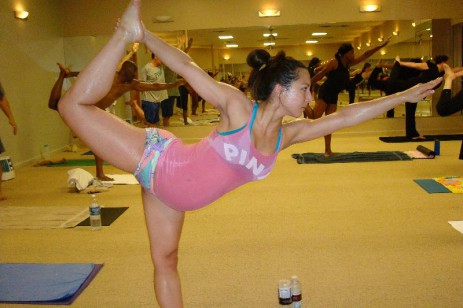
1. To my mind the main contraindications re problems with the heart and blood vessels, such as heart defect, hypertension, and problems with mitral and aortic valves. Even without any heart problem in the middle of the practice I felt palpitation (tachycardia), though it was impossible to measure the number of heart beats per minute. Most likely it was the reaction to fluid loss (or it could have been a reaction to physical overexposure, but there was no heavy work). In my case it could lead to a faint as I am a hypotonic type (my normal blood pressure is 90/60). Sure, the heart and blood vessels can be trained, but it should be done correctly and with gradual increase of workload.
Correspondingly, for aged people whose blood vessels lose elasticity it is better to avoid this practice.
Avoid it if you have varicosis as such conditions increase the exercise stress on blood vessels, and the practice includes standing poses as well. Also it is not recommended to go for Bikram Yoga if you have problems with blood outflow from the brain. Generally speaking, in all cases of health problems the regime and form of practice should be chosen individually.
2. Bronchial asthma. Humid air increases the probability of asthma. In the South of India there is a yoga teacher, Dr. Madhavan Munusamy, who cures people with the help of pranayamas and shatkarmas. Asthma is a very common disease there due to the humidity of the air. This group of contraindications also includes other various lung diseases.
3. Conditions of intense secretion and consumption of the water are highly stressful for kidneys.
4. In case of arthrosis it is better to use dry heat. But if the joint is inflamed it is better not to warm it at all.
5. Gall-stone disease
6. Menstruation. High temperature conditions can increase bleeding. In cases of some gynecological diseases of inflammatory type it is not recommended to warm up.
7. Raised body temperature, antritis, cold, sinusitis. Warming can only increase swelling.
8. Problems with lymph glands and thyroid gland.
9. People with diabetes should always be attentive while choosing physical exercises as increased activity can cause an abrupt drop of sugar concentration in the blood. It is recommended to drink a cup of sweet tea before the class.
This is a short list of diseases. I think that any person with medical background can easily broaden it after visiting the class.
My resume: this is a purely physical practice suitable for those who do not have health problems mentioned in the list above. In conditions of Russian winter you can easily get a heat stroke just after entering such an overheated place. Before going outside you should wait for a long time until you chill out.
Well, “think yourself, decide yourself” whether to get heated or not. Take into consideration everything that is written above so that to profit from the practice and not vice versa.
I would like to add that effects from practicing this exactly method can be achieved through a correct practice of any authoritative style of hatha yoga: “Bikram Yoga has a number of positive effects, such as improved blood circulation, increased strength, endurance, flexibility, excessive weight loss and improved metabolism. Regular practice improves immunity and helps to cope with symptoms of chronic diseases such as diabetes, asthma, arthritis and dysfunctions of thyroid gland.”
Anastasiya Schedrina. Bikram Yoga from the point of view of Ayurveda
Let’s look at Bikram Yoga practice from the point of view of Ayurveda. Let’s study all the aspects as required by Ayurvedic medicine, what in the practice of hot yoga and how influences doshas in our organism.
So, without taking into account some strangeness of the asanas and their choice within the method of hot yoga, let’s just look at its effects.
The first is (it can’t be argued) the detoxication effect. It is true, the water consumed before the practice, in conditions of unusual heat combined with movements uneasy for the heart, washes out all the bad and… the good as well to some extent.
But this detox has some side effects unlike other alternative and safe detox methods. For example, three-five days of detox in Ayurvedic clinic take into consideration all specifics of the organism; a doctor gives special herbal medications to support the work of the liver and the kidneys that are working actively in any type of detox. Conditions of internal organs are also taken into consideration. A diet is combined with a special massage that helps to take all the bad out of lymph and extract it through the digestive system. This is why after this type of detox the weight continues to go down (if it is excessive), and overall heath continues to improve in case of keeping up the diet. Besides, such detox does not have any side effects and is strictly individual.
What does happen with doshas’ balance in the body during hot yoga practice?
Hot yoga warms and dries out the body. Let’s remember, who does have cold and wet qualities within Ayurvedic classification? Exactly, a person with excessive kapha in his organism. It is kapha that possess qualities of the cold and humidity. It looks like all kapha-type people could have been recommended to do hot yoga. It is so, but not exactly. There are lots of limitations.
Increased kapha in the organism often provoke cysts and myomas, and these are contraindications for hot yoga. In reality hot yoga with its detox effect, warming effect and drying effect can be recommended only for an absolutely healthy kapha-type people without big excessive weight or with a slight imbalance of doshas (for example, in winter you are kapha, you’ve gained a bit of weight and got tired of cold). In all other cases (if you have a myoma or a cyst), problems with the heart or anything from the mentioned above in the article by Tatyana, hot yoga is strictly contraindicated to you.
There is another big risk to consider excessive weight as an increased kapha and to go for hot yoga. Why is it a risk? Increase of kapha may be a consequence of initial imbalance of other doshas (especially vata, which makes 80% of all reasons of disorders). In this case you will warm up your kapha but at the same time you will dry out your already dry vata and this will increase vata-type disorders in your organism. Especially, paying attention to the fact that the way of life of people in a big city is a way to vata-type imbalance: high buildings, conditioners, excess of speech, stress, alcohol, caffeine, sugar, noises and misbalanced regime of the day.
Hot yoga has one tricky effect, Ayurveda warns all the practitioners: drying and overheating of the organism will immediately lead to replenishment of the natural imbalance, operating by the concept of six tastes, the increase of heat and dryness in a body provoke desires for sweet, acid and salty tastes. Salty will replenish “kilograms” lost; sweet will increase kapha because it possesses heavy and chilling qualities. If a kapha-type person, being absolutely healthy, would regularly visit hot yoga, and also change his nutrition a bit (his body would call for it after each class) he would definitely gain weight.
It means that hot yoga can help a healthy kapha-type person only if he keeps a strict diet. Most likely you would constantly struggle appearing desires to eat something salty or sweet. It is not a harmony in yoga but a constant fight with yourself.
Tanya was right mentioning that Bikram Yoga practice is more a fitness that includes no other aspects of yoga except for asanas.
After reading this commentary hot yoga adepts might reproach me for the fact that we are not in the topic and visited only one class. Now I would say that I began practicing hot yoga in 2009 and visited the classes episodically, so an overall experience I have is more than four years. But I know my body and I can professionally assess when I need hot yoga and when I don’t. When I know that my kapha is slightly increasing (while other doshas are in the norm) after several holiday dinners or a change of regime of physical activity and the climate and it is winter or spring (time of kapha), I can allow myself to get warm and sweat once a week. I understand that I am not doing yoga but fitness, and I am sure that at this very moment it is not harmful for me.
Take care of yourself and listen to your body!
***
Blog of Tatyana Turaeva: evergreencenter.ru/turaeva







